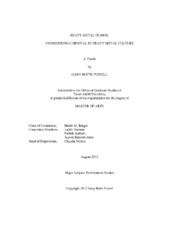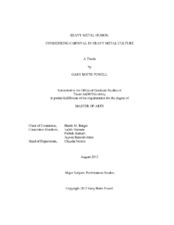| dc.description.abstract | What can 15th century France and heavy metal have in common? In Heavy Metal Humor, Gary Powell explores metal culture through the work of Mikael Bakhtin‘s “carnivalesque theory.” Describing the practice of inverting commonly understood notions of respectability and the increasing attempts to normalize them, Bakhtin argues that carnivals in Francois Rabelais’ work illustrate a sacrilegious uprising by the peasant classes during carnival days against dogmatic aristocrats. Powell asserts that Rabelais’ work describes cartoonish carnivals that continue in as exaggerated themes and tropes into other literary styles, such as comedy and horror that ultimately inform modern-day metal culture.
To highlight the similarities of Bakhtin’s interpretation of Rabelais’ work to modern-day metal culture, Powell draw parallels to between Bakhtin’s carnivalesque theory and metal culture with two different, exemplary “humorous” metal performances, GWAR and Anal Cunt. Powell chooses “humorous” metal groups because, to achieve their humor, they exaggerate tropes, and behaviors in metal culture. To this end, Powell explores metal culture through GWAR, a costumed band who sprays their audience with fake body fluids as they decapitate effigies. He points out examples of Rabelais’ work which Bakhtin uses to describe carnivalesque tropes, and threads them to modern-day metal culture. Powell then indicates how carnivalesque performances amplify with Anal Cunt, a “satirical” hateful, grindcore group. In the band’s performance which is both serious and humorous at once, Anal Cunt draws on several carnivalesque behaviors. To dissect this band’s performance, Powell augments Bakhtin’s carnivalesque theory with Richard Schechner’s theory of “dark play” and Johan Huizinga’s “play communities” to more describe and illustrate why some aspects of modern-day metal culture do not match Bakhtin’s theory based on medieval French literature.
However, carnivalesque humor becomes ambiguous and social and political problems arise as it escalates. As disrespectability is promoted, social and political tensions surface. Countering Bakhtin’s utopian notion of carnivalesque uprising, Powell highlights how socio-political turmoil presents itself in carnivalesque performance by referring to examples of confusion and concern regarding racism and sexism, something left unexplored in Bakhtin’s work. Powell suggests expanding and modernizing Bakhtin’s carnival could open pathways toward solutions to carnival culture’s socio-political ills. | en |



